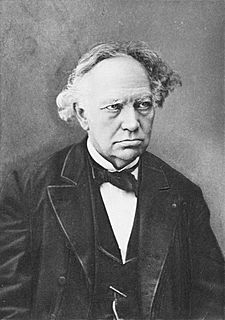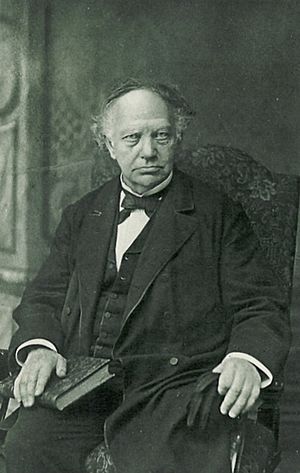Charles Hermite facts for kids
Quick facts for kids
Charles Hermite
|
|
|---|---|

Charles Hermite
|
|
| Born | 24 December 1822 |
| Died | 14 January 1901 (aged 78) |
| Nationality | French |
| Alma mater | Collège Henri IV, Sorbonne Collège Louis-le-Grand, Sorbonne |
| Known for | Proof that e is transcendental Hermitian adjoint Hermitian form Hermitian function Hermitian matrix Hermitian metric Hermitian operator Hermite polynomials Hermitian transpose Hermitian wavelet |
| Scientific career | |
| Fields | Mathematics |
| Institutions | |
| Doctoral advisor | Eugène Charles Catalan |
| Doctoral students | Léon Charve Henri Padé Mihailo Petrović Henri Poincaré Thomas Stieltjes Jules Tannery |
Charles Hermite (born December 24, 1822 – died January 14, 1901) was a famous French mathematician. He made important discoveries in many areas of math. These included number theory, which studies whole numbers, and algebra, which uses symbols to solve equations.
Many math ideas are named after him. These include Hermite polynomials and Hermitian operators. One of his students was another very famous mathematician, Henri Poincaré.
Hermite was the first to prove that the number e is a transcendental number. This means e cannot be the root of a polynomial equation with integer coefficients. Later, his methods helped another mathematician, Ferdinand von Lindemann, prove that π is also a transcendental number.
A Life in Mathematics
Charles Hermite was born in Dieuze, France, on December 24, 1822. He was born with a foot problem that made it hard for him to walk throughout his life. He was one of seven children. His father worked in a fabric business and was also an artist.
Charles went to school in Nancy and then in Paris. He loved reading math books by famous mathematicians like Joseph-Louis Lagrange and Carl Friedrich Gauss. These books helped him learn a lot about numbers and equations.
Hermite really wanted to study at the École Polytechnique. This was a top military school known for its excellent math and science programs. He spent a year preparing for the tough entrance exam with the help of mathematician Eugène Charles Catalan.
In 1842, he got into the school. However, after just one year, the school wouldn't let him continue because of his foot. Hermite tried hard to get back in, but the school set very strict rules. He decided not to accept these rules and left the École Polytechnique without finishing his degree.
Even without graduating, Hermite made his first big math discovery in 1842. He found a simpler way to prove that some equations, like those with a fifth power, cannot be solved using only basic algebra.
He also wrote letters to another great mathematician, Carl Gustav Jacob Jacobi. Their discussions led to Hermite's work being included in Jacobi's collected papers. This showed how important Hermite's ideas were.
After leaving school, Hermite spent five years studying math on his own. During this time, he became friends with other important mathematicians like Joseph Bertrand and Joseph Liouville. In 1847, he passed his final exams and earned his degree. The next year, he married Louise Bertrand, who was Joseph Bertrand's sister.
In 1848, Hermite returned to the École Polytechnique, this time as a teacher. He also became a professor of mathematics at the University of Paris (Sorbonne) in 1869. He taught at these famous universities until he passed away.
Important Math Discoveries
Charles Hermite was a very inspiring teacher. He wanted his students to see the beauty in math and not get too caught up in tiny details. He helped many young scientists start their careers. His published lectures also had a big impact on how math was taught.
His most important original discoveries were about special types of math functions. These included Abelian functions and elliptic functions, which are advanced topics in math. He also made big contributions to number theory.
In 1858, Hermite showed that certain complex equations (fifth-degree equations) could be solved using elliptic functions. This was a major breakthrough.
His most famous achievement came in 1873. He proved that the number e is a transcendental number. This was a huge step in mathematics. Just nine years later, in 1882, Ferdinand von Lindemann used similar methods to prove that π is also transcendental.
A Famous Quote
Charles Hermite once wrote about the challenge of proving that pi is transcendental:
I shall risk nothing on an attempt to prove the transcendence of π. If others undertake this enterprise, no one will be happier than I in their success. But believe me, it will not fail to cost them some effort.
Lasting Impact
Besides the many mathematical ideas named after him, Charles Hermite also has a crater on the Moon named in his honor. The Hermite crater is located near the Moon's north pole.
See also
 In Spanish: Charles Hermite para niños
In Spanish: Charles Hermite para niños
- List of things named after Charles Hermite
- Hermitian manifold
- Hermite interpolation
- Hermite's cotangent identity
- Hermite reciprocity
- Ramanujan's constant


